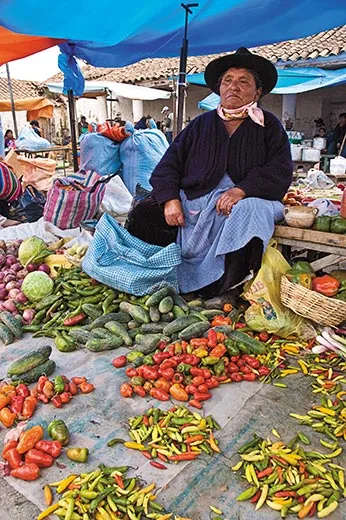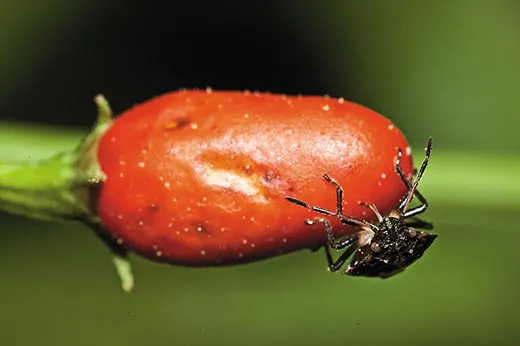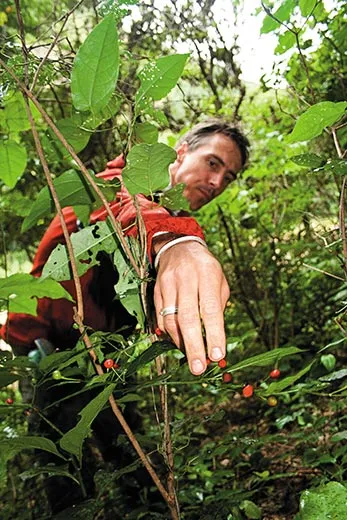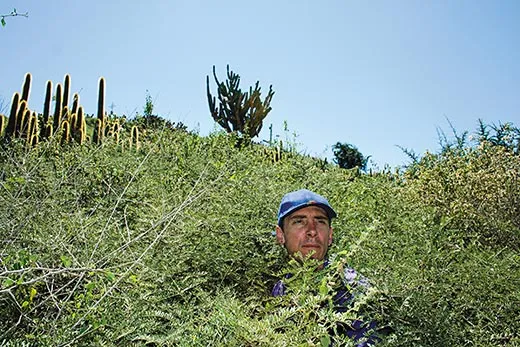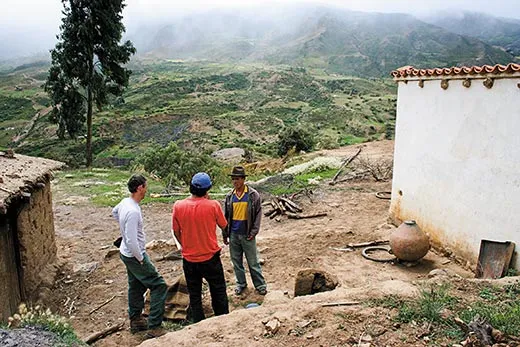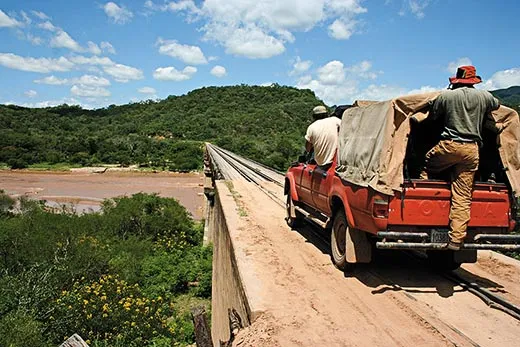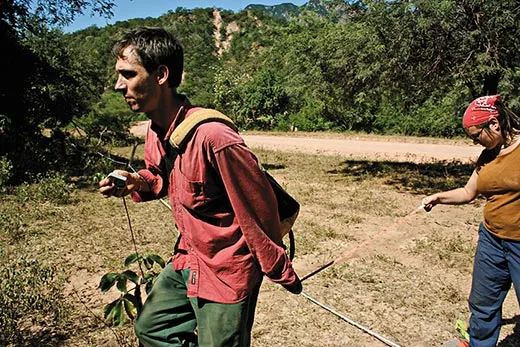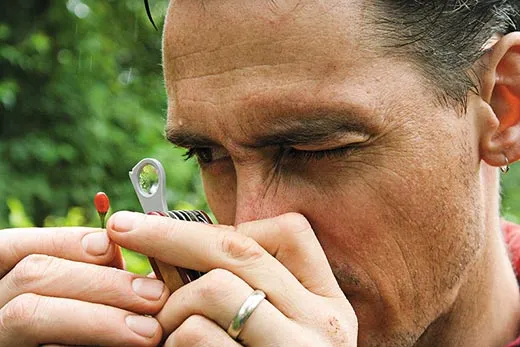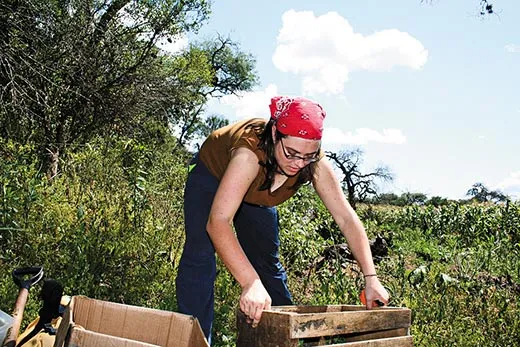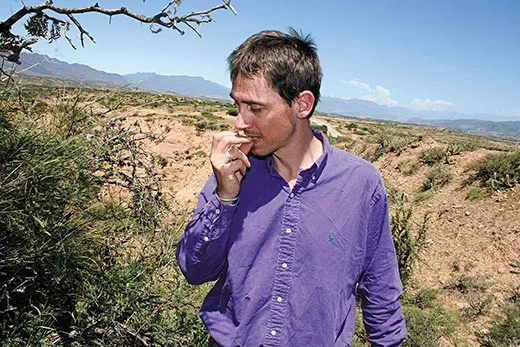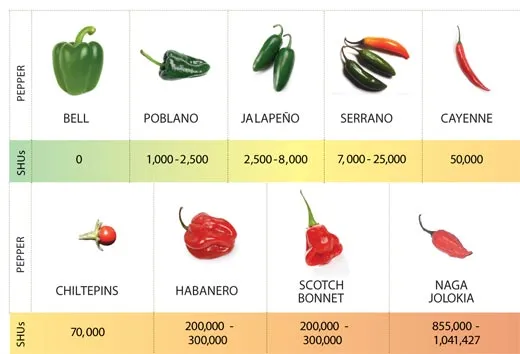What’s So Hot About Chili Peppers?
An American ecologist travels through the Bolivian forest to answer burning questions about the spice
/https://tf-cmsv2-smithsonianmag-media.s3.amazonaws.com/filer/bug-on-chili-631.jpg)
Seated in the bed of a pickup truck, Joshua Tewksbury cringes with every curve and pothole as we bounce along the edge of Amboró National Park in central Bolivia. After 2,000 miles on some of the worst roads in South America, the truck's suspension is failing. In the past hour, two leaf springs—metal bands that prevent the axle from crashing into the wheel well—jangled onto the road behind us. At any moment, Tewksbury's extraordinary hunting expedition could come to an abrupt end.
A wiry 40-year-old ecologist at the University of Washington, Tewksbury is risking his sacroiliac in this fly-infested forest looking for a wild chili with a juicy red berry and a tiny flower: Capsicum minutiflorum. He hopes it'll help answer the hottest question in botany: Why are chilies spicy?
Bolivia is believed to be the chili's motherland, home to dozens of wild species that may be the ancestors of all the world's chili varieties—from the mild bell pepper to the medium jalapeño to the rough-skinned naga jolokia, the hottest pepper ever tested. The heat-generating compound in chilies, capsaicin, has long been known to affect taste buds, nerve cells and nasal membranes (it puts the sting in pepper spray). But its function in wild chili plants has been mysterious.
Which is why Tewksbury and his colleagues have made multiple trips to Bolivia over the past four years. They're most interested in mild chilies, especially those growing near hot ones of the same species—the idea being that a wild chili lacking capsaicin might serve as a kind of exception that proves the rule, betraying the secret purpose of this curiously beloved spice.
Bounding along in the truck, we reach a cluster of houses next to a river. Somewhere near this spot a few years ago, Michael Nee of the New York Botanical Garden collected a C. minutiflorum specimen, and Tewksbury wants to sample its relatives. In his notes, Nee wrote that the fruit he tasted was sweet. But Tewksbury just encountered the same species several hundred miles away and tasted it himself. That one was spicy, and the discrepancy was worth investigating.
Tewksbury pops a wad of coca leaves—the source of cocaine and Bolivia's answer to espresso—into his mouth and steps smiling into the drizzling rain. A middle-aged man appears outside a low-slung house, his tan shirt open to his belt. Tewksbury says one benefit of his research is he doesn't have to look too hard for his subject. He just asks the local residents, tossing out a few Bolivian names for wild chilies: Any ulupica? Any arivivi?
The man shakes his head at the crazy gringo. Here? No. Up the mountain. Tewksbury is puzzled. "Are there any peppers without the spice?" he asks in broken Spanish. No, the man says. Tewksbury shrugs and crosses the highway to another yard, where a woman stands with a mop. She, too, says he must be mistaken. There's no ulupica here.
The other four people in our group linger at the vehicle. We're wet. Biting flies leave red welts on our necks and arms. Noelle Machnicki, a University of Washington graduate student, has a plane to catch. Tewksbury marches down the road, hops over a strand of barbed wire, and lumbers up a slope through a tangle of moist weeds. The others make halfhearted efforts to scan the area around the truck, while I follow Tewksbury up the hill. As he enters the forest, marble-size red globes catch his eye: C. minutiflorum. Tewksbury bites into a fruit. "Not pungent," he says, slipping a few into an envelope.
He walks over to another plant. It, too, is sweet. Soon he has tasted fruits from eight plants and not one is spicy. This could well be an entirely mild wild chili population—the first ever—he muses, then erupts into a frenzy of free association, cooking up evolutionary trees for the strange chilies. Suddenly, a monkey in the canopy above us leaps from one branch to the next, and rainwater cascades onto our heads. Tewksbury watches the animal's acrobatics before performing some of his own: a vine snags his ankle and he tumbles face first into a chili bush, another C. minutiflorum. Dazed, he plucks a fruit and bites into it. He spits it out and grimaces—this one is hot. He couldn't be happier.
People have been spicing up their food with chilies for at least 8,000 years. At first they used wild chilies, likely adding them to potatoes, grain and corn, says Linda Perry, an archaeobotanist at Smithsonian's National Museum of Natural History. She has found traces of chilies on ancient milling stones and cooking pots from the Bahamas to southern Peru. Based on her studies of potsherds from different archaeological sites, she concludes that people in the Americas began cultivating chilies more than 6,000 years ago. Just why they did is a matter of scholarly debate. Perry believes it was a question of taste. "Chilies were domesticated early and spread very quickly just because people like them," she says. "Do you want a big pot of yams or a pot of yams with chilies thrown in?" Other researchers, such as Jennifer Billing and Paul Sherman at Cornell University, argue that people learned early on that chilies could reduce food spoilage. And some scholars point to medical uses. Ancient Mayans incorporated chilies into medicinal preparations for treating infected wounds, gastrointestinal problems and earaches. Laboratory studies have shown that chili pepper extracts inhibit a number of microbial pathogens, and capsaicin has been used in a local anesthetic.
Whatever the benefits, chilies spread around the world with astonishing speed, thanks in part to Christopher Columbus. In 1492, the explorer encountered some plants cultivated by the Arawak Indians in Hispaniola. Convinced he had landed in India, he referred to them as "pepper," an unrelated spice native to the subcontinent. "The land was found to produce much ají, which is the pepper of the inhabitants, and more valuable than the common sort [black pepper]," he later wrote. "They deem it very wholesome and eat nothing without it." Columbus took chilies back to Spain, but they initially were unappreciated in Europe. The Portuguese got acquainted with chilies at their trading post in Pernambuco, Brazil, and carried them, with tobacco and cotton, to Africa. Within 50 years of Columbus' voyages, Pernambuco chilies were being cultivated in India, Japan and China. Chilies made it to the American Colonies with the English in 1621.
In the United States, where chilies were once an exotic spice, consumption increased by 38 percent between 1995 and 2005. The rise reflects both the influx of immigrants from countries where spicy food is common and more adventurous eating among the general population. According to the U.S. Department of Agriculture, the average American now consumes 5.9 pounds of chilies a year, more than the per capita consumption of asparagus, cauliflower or green peas.
When people call chilies "hot," they're not just speaking metaphorically. Capsaicin stimulates the neural sensors in the tongue and skin that also detect rising temperatures. As far as these neurons and the brain are concerned, your mouth is on fire. (Similarly, mint stimulates a type of neural receptor sensitive to cool temperatures.) With enough heat, adrenaline flows and the heart pumps faster. This reaction, according to some physiologists, is part of what makes peppers so enticing.
The scale that scientists use to describe a chili's heat was developed in 1912 by Wilbur Scoville, a chemist at Parke-Davis pharmaceutical company in Detroit. He would dilute a pepper extract in sugar water until the heat was no longer detectable by a panel of trained tasters; that threshold is its Scoville rating. A bell pepper, for instance, merits a zero, while a typical jalapeño falls between 2,500 and 8,000 Scoville heat units (SHUs). Last year, the naga jolokia, which is cultivated in India, rated a whopping one million SHUs. What's remarkable is that this variation can occur within a single species. The cayenne pepper, C. annuum—50,000 SHUs—is the species from which countless domesticated varieties of bell peppers, jalapeños and poblanos were derived.
Tewksbury first studied chilies near the Tumacácori mission in the mountains of southern Arizona—home to the world's northernmost wild variety, chiltepins. The Rev. Ignaz Pfefferkorn had developed a liking for chiltepins there in the 1750s. Pfefferkorn (whose name means "peppercorn" in German) called them "hell-fire in my mouth." In 1999, Tewksbury and Gary Nabhan, who co-founded Native Seeds/Search, an organization that works to preserve indigenous agricultural plants of the Southwest, established the Wild Chile Botanical Area in Tumacácori. That's when Tewksbury started wondering why chilies were hot.
Chilies, like other fruits, lure birds and other animals to eat them and disperse their seeds. But chilies also attract seed predators, like rodents, that crush seeds and make germination impossible. Many plants produce toxic or foul-tasting chemicals that deter seed predators, but these chemicals are usually found in the plant's leaves and roots as well as its fruit. In chilies, however, capsaicin is found only in the fruit—secreted via a special gland near the stem—and its production increases dramatically as the fruit ripens. Tewksbury and Nabhan suspected that capsaicin protects chilies from rodents.
To test the theory, Tewksbury wanted to compare spicy and mild chilies from the same species, if only he could find some. He contacted Paul Bosland, of the Chile Pepper Institute at New Mexico State University, who maintains a huge collection of chili seeds. Bosland told Tewksbury that he had tasted an unusual chili in his greenhouse one day in 1996. "I took a bite of it just to see what it tasted like and I said ‘hmm' that fruit doesn't seem to have any heat," he recalls. "So, I took another one and I said ‘hmm' that one doesn't either." The chili had come from seeds collected in Bolivia 37 years earlier. Bosland took note of it, wrote it off as a mutant and placed the seeds back in the freezer. But after Tewksbury called, he pulled them out again.
Tewksbury used the seeds to grow chiles for his experiments. When he offered the fruits of those labors to laboratory packrats and cactus mice, the rodents ate the mild chilies but avoided the hot ones. Such studies convinced him "that capsaicin is all about parental care," Tewksbury says. "It's all about plants caring for their offspring," the fruits. He later found that capsaicin also has the strange effect of slowing birds' digestive systems, which helps some seeds germinate, possibly by softening the seed coat. (Birds don't mind eating capsaicin; in fact, some backyard birdwatchers spike their birdseed with chili powder to stop squirrels from raiding feeders.) Even so, Tewksbury didn't believe that deterring rodents and slowing bird digestion were enough to explain why spiciness evolved in the first place. Instead, he has come to think that a chili's heat protects it from much smaller foes.
In Bolivia, fungal rot is a more pervasive threat than rodents. More than 90 percent of ripe wild chili fruits contain signs of fungal infection; it is the primary reason seeds die prior to being dispersed. Back in the lab in Seattle, Machnicki has found that just one fungus—from the Fusarium genus, light pink in color—is the main culprit regardless of the chili species. "It's not a random fungus," says Machnicki. "It's strongly associated with these chili peppers."
In looking at pepper populations that contain both spicy and mild plants, Tewksbury and Machnicki have found that the more capsaicin, the less fungal infection. Furthermore, the fungus thrives in humid environments, and Tewksbury and colleagues have found that chilies in Bolivia seem to adjust accordingly: the moister the climate, the spicier the chilies. In the lab, fungus raised from mild peppers is easily inhibited by a little spiciness, whereas fungus from spicier pepper populations can withstand more heat.
"Capsaicin demonstrates the incredible elegance of evolution," says Tewksbury. The specialized chemical deters microbes—humans harness this ability when they use chilies to preserve food—but capsaicin doesn't deter birds from eating chili fruits and spreading seeds. "Once in a while, the complex, often conflicting demands that natural selection places on complex traits results in a truly elegant solution. This is one of those times."
William Foley, a nutritional ecologist at the Australian National University in Canberra, says Tewksbury is "working on the right system to answer tricky ecological questions people have been asking for a long time." Denise Dearing, an ecologist at the University of Utah, calls Tewksbury's research "the most in-depth work on a plant-frugivore [fruit eater] interaction." Tewksbury's success comes in part from his fearless exploration of the chili's motherland. Adds Foley: "You can't expect to understand complex interactions between plants and animals unless you're actually in the field."
It takes a special kind of perseverance to conduct fieldwork in the Gran Chaco, a dry forest wilderness that covers 500,000 square miles in Paraguay, Argentina, Brazil and Bolivia. In Bolivia, only 6 percent of the roads are paved and gasoline and accurate maps are hard to come by. Weather fluctuates between oppressive heat and torrential rain—turning roads into mud wallows. The researchers' truck is outfitted with two spare tires, but it was once stopped by a third flat. In the course of their research, the scientists have lost a wheel (loose lug nuts), snapped an axle (inexperienced driver) and cracked the engine block (river crossing). Their sponsoring organization, the Fundación Amigos de la Naturaleza, had to replace the entire vehicle when it was stolen in 2003.
Tewksbury says his fieldwork runs on three compounds: coca, caffeine and capsaicin. But his fascination with natural products and his seeming indefatigability may have deeper roots. His father, Peter Tewksbury, was the director of the 1950s TV sitcoms "My Three Sons" and "Father Knows Best" and the short-lived but acclaimed series "It's a Man's World," which featured Josh's mother, Cielle, acting under the name Ann Schuyler. Peter would eventually direct Elvis Presley in Stay Away, Joe and The Trouble With Girls and worked briefly with J. D. Salinger in a failed attempt to bring one of his short stories to the screen. Eventually fed up with the constraints of Hollywood, Peter came home one day in the 1970s, pulled his Emmy Award from the closet and chucked it into the trash can. "It was one of his bitter moments," Cielle recalls. "He had an incredible sense of morality and ethics, and it just didn't match with a Hollywood career." As Peter himself would later tell the New York Times, "Peter Tewksbury the director is dead."
The couple packed up the car and drove with their two children to Vermont, where they adopted the names Henry and Mary Jane. "Henry" became a renowned cheese expert and the author of The Cheeses of Vermont: A Gourmet Guide to Vermont's Artisanal Cheesemakers. They home-schooled Josh and his sister, Marintha, and moved among Vermont, Quebec, Oregon and a ranch in California. Peter Tewksbury died in 2003 at age 79. "When [Peter] would glom onto something he wanted to do, it was just [at] a dead run," says Cielle, 71, who teaches the Taoist philosophy tai chi and Chinese sword and saber techniques in Brattleboro, Vermont. "There's quite a bit of him in Josh: the excitement, the drive and the complete dedication and focus."
Indeed, some mornings in Bolivia, Josh Tewksbury was in such a rush to get out to the field that he'd put his shirt on inside out or backward. Talking about science, he would get a faraway look and say, "that would be slick." From the back of the truck one day, he yelled to colleagues riding in the cab about a new experiment he was contemplating. Carlos Manchego, a student at Bolivia's Natural History Museum, and Tomás Carlo, an ecologist at Pennsylvania State University, spent the next hour hashing it out with Tewksbury as they hung out the windows, clutching the roof rack.
His zeal can sometimes get the better of him. About eight years ago, he and Doug Levey of the University of Florida, an expert on plant and animal interactions, were visiting Ilha do Cardoso off the coast of Brazil. The duo became convinced they had uncovered a novelty: a fungus whose spores were dispersed by a bird. They spent several days frantically collecting samples with hopes of culturing the fungus back in the lab. They hoped to submit their findings to a prestigious journal. But when they finally examined the "fungus" under a microscope, they noticed it had legs—and there's nothing unusual about birds eating insects.
But Levey points out that even Tewksbury's misguided enthusiasms may prove fruitful: "There's a long history in science of the most important discoveries being made by accident or by following a whim."
"I think this is insane right now," says Machnicki as she plucks a huge spine out of the back of her knee. Her nylon quick-dry pants are no match for the Bolivian forest. At her feet, a snake-like cactus winds among thickets of spiny ground bromeliads ("my nemesis," she calls them), thorny shrubs and the bulbous stem of the devil nettle.
We had camped the night before on a low plateau overlooking the Paraguayan border. Our breakfast—and the last of our food supplies—consisted of a thimbleful of cold coffee, a boxed juice drink and a modest bag of trail mix. Instead of moving on as planned, Tewksbury's wandering legs took him to an unexpected patch of chilies. He was soon stringing a measuring tape through the woods to count every one of them in a plot some 200 yards on each side. After two years of laboratory work, Machnicki, a fungus expert, is finally getting a chance to see the natural habitat where her seed-killing fungus thrives. At the moment, though, she would rather be eating lunch. "Everything with him is by the seat of your pants," she would tell me later.
After Tewksbury paces off the census plot, the team spreads out and begins scouting chilies. Carlo points a laser rangefinder at Tewksbury, who is hovering over a chili plant, so that Carlo can add the plant to a map he's drawing. Tewksbury counts fruits, both ripe and unripe, and assesses their pungency, which is a bit like playing Russian roulette. "I think it's going to hurt," the human capsaicin meter says as he pops a fruit in his mouth. "Ah!" he yelps. (They will test samples more rigorously back in the lab in Seattle.)
Tewksbury scans the plants for fruit-sucking bugs, using his own nicknames. "Red-shouldered beetle mimic," Tewksbury yells, referring to a true bug (order Hemiptera) he once thought was a beetle (order Coleoptera) until an entomologist set him straight. "One, two, three—oh—and red butts!" he says, noticing another insect species that hangs out on the underside of the chili leaves.
During a previous expedition, Levey realized that such bugs may be spreading the seed-killing fungus from chili plant to chili plant. While the rest of the team was out sampling chilies, Levey was stuck in camp, recovering from a bout of intestinal distress. As a distraction, he says, he spent a lot of time examining chilies with a magnifying glass, "and I discovered that a lot of them were pitted with holes from these bugs. When I opened them, I could see traces of fungal infection on the seeds themselves." This fungus was either hitchhiking from fruit to fruit on the proboscis of these bugs, or else the bugs' piercings were simply making it easier for the fungus to infiltrate the flesh.
In any event, the critical test of the theory that capsaicin is an adaptation to fight fungus would come from growing pungent and nonpungent chilies next to each other in the wild to find out if one type does better than the other. Last field season, Tewksbury had hired a man named Don Odon to tend a thousand chili plants at his remote ranch in preparation for the test. But only three plants survived. The rest may have fallen victim to Don Odon's enthusiastic watering regime. If Tewksbury was discouraged when we visited the ranch, he didn't show it.
As we traced our zigzag path southward, he found a huge crop of young wild plants with mild chilies in the town of Yuqueriti. Then we drove on for hours. But when the team woke up the next morning in Charagua, Tewksbury had a "slick" idea. We could race back to Yuqueriti, dig up the mild chili seedlings and haul them several hundred miles to a ranch in the Andean foothills where the plants are all spicy, to learn which are hardier. Tewksbury's enthusiasm can be hard to argue with, and six hours later I would find myself bouncing along in the back of the truck, trying to keep myself and 89 uprooted chili plants from being crushed under a pile of luggage.
Two days later, when we arrive at the ranch in the foothills, Tewksbury observes that the native chili peppers have been "hammered" by drought and cattle grazing. He doesn't think his experimental seedlings would survive in these conditions. He finds another ranch where the owner will allow the team to plant the seedlings on the edge of a cornfield. For a small fee, the owner agrees to tend them. Tewksbury is in high spirits as the team plants each mild chili next to a wild spicy one. When the plants begin fruiting next year, they'll see how many fruits survive and how much fungus they have. Ideally, the team would also dig up spicy plants in the foothills and transplant them near mild plants in Yuqueriti. But this is seat-of-your-pants science, and Tewksbury will have to wait a year to get a more substantial experiment going. "I hope to be working on this system for another 10 to 20 years," he says as he pats soil around the last chili plant. "I can't see myself running out of questions in less than that."
Brendan Borrell wrote about cassowaries in the October, 2008 issue of Smithsonian. He lives in Brooklyn, New York.
